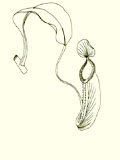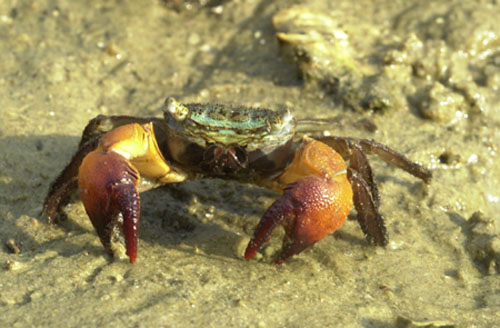

 |
 |
Diversity At A Glance (pdf)
This column aims to introduce interesting species of Hong Kong flora and fauna that might be encountered during fieldwork. Distinctive physical characteristics and some interesting ecological facts are included for each example. If you wish to contribute to this column, or have any comments or suggestions, please contact eitherJacqueline Weir (jesweir@hkusua.hku.hk) or Sukh Mantel (skmantel@hkusua.hku.hk)
|
|
|
|
|
'Perisesarma bidens'
by David Poon
Perisesarma bidens (Grapsidae: Sesarminae) is one of the commonest mangrove crabs in Hong Kong. You can easily distinguish it from other crabs by its orange chelae and the greenish/olive green carapace. Also, as the name implies, this species has two "teeth" (hence bi-dens) on the lateral sides of the carapace.
As dominant mangrove fauna, P. bidens are highly adapted for their semi-terrestrial lifestyle. They possess a gill chamber and a modified breathing mechanism typical in many sesarmine crabs [for further details, see Warner’s (1977) classic work]. They are burrowers but appear to have a strong preference for natural refuges such as rock crevices, under boulders and between interstices of mangrove root buttresses. They can also be found in high intertidal grass patches and near freshwater sources, indicating their tolerance to salinity changes and desiccation stress. Observations have shown that they are also good climbers as they move up and cling on mangrove stems tightly during high tides, possibly as a means to avoid prolonged immersion as well as predation from aquatic predators. Spotting of P. bidens on open sand-/mudflats (that are immediately next to the mangroves) is extremely unusual. They seem to have a strong association with mangroves and their activity is, therefore, mostly restricted within the mangrove stand. Field observations suggest that they are aggressive and agonistic encounters are rather common. When kept in captivity, they tend to cannibalize.
Perisesarma bidens are swift and alert, and therefore difficult to catch. They can retreat very quickly into narrow refuges and also give a painful bite! As in many other sesarmine crabs, P. bidens play a key role in the mangrove food web as leaf litter processors. Interestingly, they also spend most of their time cropping on surface sediments, a behaviour that has been recognized, yet generally ignored by crab ecologists. The reason(s) for crabs feeding on such an apparently nutritionally inferior food item could be simple or complex, which is a good lesson to me that there is still much to be learnt about mangrove crabs’ feeding ecology.
Bibliography
Warner, G.F. (1977). The Biology of Crabs. Van Nostrand, New York. 202 pp.
 |
Fig. 1. Perisesarma bidens
|
|
P.15-16 |
|
Porcupine! |
 Copyright © 2000 |